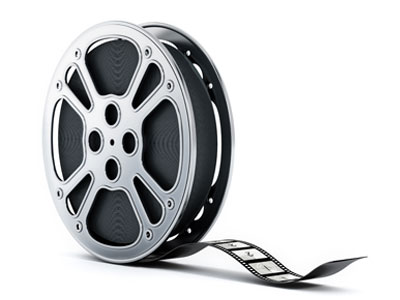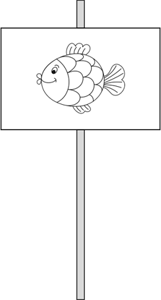How do movies move?
How does this align with my curriculum?
Explore the concept of persistence of vision in this hands on activity.
What You Need
- Glue or stapler
- Paper strip
- Pencil or marker
- Straw
What To Do
- Cut paper into a strip approximately 8 x 24 cm.
- Fold paper in half so it forms a card.
- On one side, draw a picture of a fish; on the other side, draw a picture of a bowl (decoration can be added).
- Open the paper and place a straw in the middle of one side so it looks like a popsicle stick (not like a flag).
- Fold the other side over and glue or staple the straw in place.
- Hold the straw between the palms of your hand and move back and forth rapidly so that the straw spins. Keep your eyes on the fish and the bowl.
Discovery
When the straw is rotated rapidly, the fish appears to be inside the bowl. Whenever we see an image, the brain holds onto that image for a short time (1/16 of a second). If another image appears within that time, we will see both images. This is called persistence of vision.
Movies and cartoons depend on this phenomenon. If approximately 24 slightly different pictures move in front of the eye each second, they will blend together to make a moving picture. Motion pictures consist of still pictures (frames) that move across a screen at 24 frames per second.
- Try spinning the straw at different speeds. How fast does it have to turn before you can no longer see two separate images?
For more information on this topic check out these Let's Talk Science resources:
- How We See (Backgrounders) - Learn about how human vision works as well as some common types of vision problems.
- How do we see colour? (STEM in Context) - How does the human eye see visible light as colour? And why do some people see more colours than others?
- What is Persistence of Vision? (Mr. Wizard) (Video – 5:32 min.) - Mr. Wizard demonstrates how persistence of vision works.
- Persistence of Vision (Veritasium) (Video – 2:48 min.) - A demonstration of persistence of vision using a ball that emits coloured light.
What’s happening?
When the straw is rotated rapidly, the fish appears to be inside the bowl. Whenever we see an image, the brain holds onto that image for a short time (1/16 of a second). If another image appears within that time, we will see both images. This is called persistence of vision.
Why does it matter?
Movies and cartoons depend on this phenomenon. If approximately 24 slightly different pictures move in front of the eye each second, they will blend together to make a moving picture. Motion pictures consist of still pictures (frames) that move across a screen at 24 frames per second.
Investigate further
- Try spinning the straw at different speeds. How fast does it have to turn before you can no longer see two separate images?
For more information on this topic check out these Let's Talk Science resources:
- How We See (Backgrounders) - Learn about how human vision works as well as some common types of vision problems.
- How do we see colour? (STEM in Context) - How does the human eye see visible light as colour? And why do some people see more colours than others?
Additional Resources
- What is Persistence of Vision? (Mr. Wizard) (Video – 5:32 min.) - Mr. Wizard demonstrates how persistence of vision works.
- Persistence of Vision (Veritasium) (Video – 2:48 min.) - A demonstration of persistence of vision using a ball that emits coloured light.

